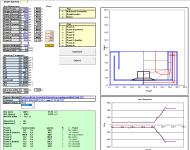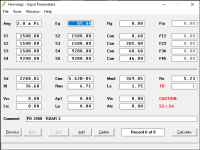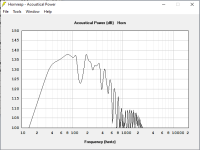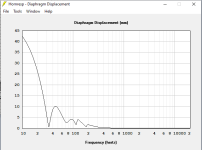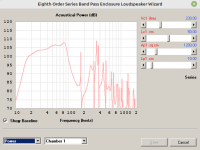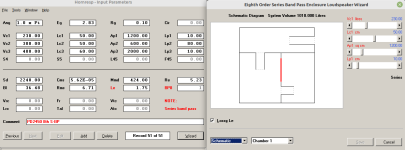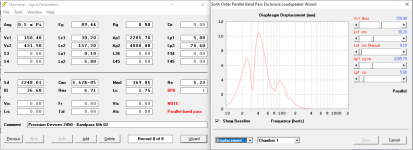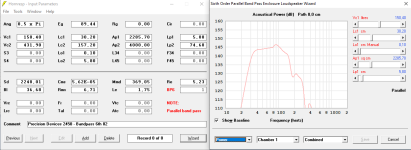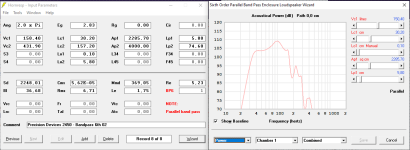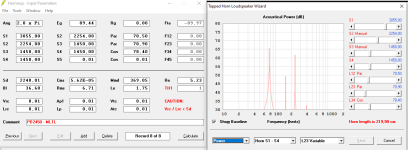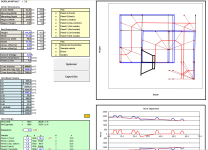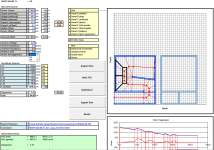Hi!
I have a pair of Precision Devices 2450, 24" speakers, which I´d like to build something else for than regular ported boxes. I have read quite a lot and experimented in hornresponse, but feel that I don't have enough experience too decide if i'm on the right track. I don't want to bulid something that doesn´t work.
On PD:s site they say that they should work in horns, but apparantly the BL isn't sufficient for example paraflex.
I´m curious about ROAR, Tapped Horn or 8th order bandpass solutions, but need some help to decide what would work. For ROAR and TH I have had some success getting a reasonable response curve, but 8th order bandpass is just a mess. I know there are a lot a very skilled builders here who propably could make it so much better.
Some things like phase response and group delay I don't have a clue how it works and would appreciate some info about that too.
If someone is interrested in helping me design boxes, I would like them to be no bigger than 185x80x90 Height, Widht, Depth, so I can get them through doors.
I'm attaching some pictures from boxplan and hornrespons so you can give me feedback.
The other part of the system will consist of 8 pcs 10", 4 pcs of 6,5 and a pair of horn tweeters. The PD 2450:s will have a Yamaha P7000s each, the 10":s a QSC PLX3402 and the 6,5 and tweeters a Pioneer SX1250. The equalisation and filtration is done by a Driverack PA2, except for the crossover between the 6,5:s and the tweeters.
I would appreciate any help I could get.
I have a pair of Precision Devices 2450, 24" speakers, which I´d like to build something else for than regular ported boxes. I have read quite a lot and experimented in hornresponse, but feel that I don't have enough experience too decide if i'm on the right track. I don't want to bulid something that doesn´t work.
On PD:s site they say that they should work in horns, but apparantly the BL isn't sufficient for example paraflex.
I´m curious about ROAR, Tapped Horn or 8th order bandpass solutions, but need some help to decide what would work. For ROAR and TH I have had some success getting a reasonable response curve, but 8th order bandpass is just a mess. I know there are a lot a very skilled builders here who propably could make it so much better.
Some things like phase response and group delay I don't have a clue how it works and would appreciate some info about that too.
If someone is interrested in helping me design boxes, I would like them to be no bigger than 185x80x90 Height, Widht, Depth, so I can get them through doors.
I'm attaching some pictures from boxplan and hornrespons so you can give me feedback.
The other part of the system will consist of 8 pcs 10", 4 pcs of 6,5 and a pair of horn tweeters. The PD 2450:s will have a Yamaha P7000s each, the 10":s a QSC PLX3402 and the 6,5 and tweeters a Pioneer SX1250. The equalisation and filtration is done by a Driverack PA2, except for the crossover between the 6,5:s and the tweeters.
I would appreciate any help I could get.
Attachments
I would not torture that huge cone with the pressure typically seen in a ROAR, TH or TP.
A 8th order series tuned bandpass with a sloping response to avoid the otherwise typical "slow" bottom-heavy sound character of a "flat" bandpass box. The mighty PD2450 seems to prefer a series-tuned BP alignment as this adds some much needed virtual Bl through acoustic positive feedback (more punch, attack and a smaller box).
I would probably build something like this and I would try hard to keep the ports and air volumes symmetrical around the driver to avoid any warping of the cone and/or suspensions due to uneven loading.
A 8th order series tuned bandpass with a sloping response to avoid the otherwise typical "slow" bottom-heavy sound character of a "flat" bandpass box. The mighty PD2450 seems to prefer a series-tuned BP alignment as this adds some much needed virtual Bl through acoustic positive feedback (more punch, attack and a smaller box).
I would probably build something like this and I would try hard to keep the ports and air volumes symmetrical around the driver to avoid any warping of the cone and/or suspensions due to uneven loading.
Attachments
It worth to investigate and benchmark before you take a decision. See the link below.
https://www.diyaudio.com/community/...nifold-mtb-be-better-than-tapped-horn.391782/
https://www.diyaudio.com/community/...nifold-mtb-be-better-than-tapped-horn.391782/
Interesting driver. Quoted Qts suggests that it might be a good match for a simple single-expansion TH like the BOXPLAN-MTH or BOXPLAN-MTHALT layouts given on my website, and the only question really is how low you wish to go. For example, here's a simple 25 Hz capable TH for one of those drivers that should fit well within your box size limitations. I used 1*PI space for the modeling because Circlomanen used that for his model, LOL. Usually I use 2*PI modeling to make it easier to compare with results from other modeling programs.
This should be considered only a starting point BTW, as the driver's semi-inductance parameters should be taken into consideration. Moving Fb up to 30 Hz will result in a smaller box or more output - take your pick. Don't forget to include the effect of the needed HP and LP filters on the overall response. And don't also forget that THs and BP boxes are typically limited to just over an octave of usable response, no matter what the frequency response curves tell you 🙂.


This should be considered only a starting point BTW, as the driver's semi-inductance parameters should be taken into consideration. Moving Fb up to 30 Hz will result in a smaller box or more output - take your pick. Don't forget to include the effect of the needed HP and LP filters on the overall response. And don't also forget that THs and BP boxes are typically limited to just over an octave of usable response, no matter what the frequency response curves tell you 🙂.
I put a lot of time writing answers and suddenly my computer died. Sorry if the answers are get a bit short now - my motivation is quite a bit lower at the moment.
@Circlomanen
I thought ROAR was easier on the cone and needed less BL than paraflex. I also thought the cone got a more even load in a ROAR than a TH, an that would relive it a bit. But if you say it is a bad idea i guess it is.
Would there be any backsides with building a 8th order BP with chamber 1 and 2 in parallell, or at 6th order parallell BP if you could get a slope on the frequency response?
@Audiodidakt
I could see that they built a bassreflex with success and that there were some attached files of frequency responses that to me seemed very uneven. What is it you want me to see? Can you please do a simulation so I understand?
@LORDSANSUI
I have never heard of MTB before, but I would be glad if you could make a simulation. It sounds interresting, but I don't know where to start in hornresp.
@Brian Steele
If the BOXPLAN-MTHALT would work it could be an option - though it's not prio one, I think it would be cool i the magnet and cage was visible.
How can I find out the driver's semi-inductance parameters?
@All
What is good frequencyresponse? I have seen a lot of curves on horns and usually they are very steep downwards from 50 Hz. The Warfedale Pro -Delta F18H for example has 98db at 50Hz, 94 db at 40 Hz, 92db at 30Hz and 76 db at 20 Hz. Will a horn like that sound bad? I have read that the kick in the chest is between 60 and 80 Hz and that there isn't a lot going on below 35Hz, am I wrong?
The simulations you have done play lower? Do I need that in real world musik?
I made a simulation of a 6th order bandpass. do you think it will play ok or is it tuned to high if you look at the attached files? Is it buildable - i tried put the numbers in boxplan BOXPLAN-BP6P2 but couldn't figure out how to change to chambers. Some distances like Lc1 seemed to be in the wrong direction, but propably it is just me misunderstanding.
It would be appreciated if someone could tell me how to do.
I have probably missed out a lot, but I'm getting really tired so this will have to do...
@Circlomanen
I thought ROAR was easier on the cone and needed less BL than paraflex. I also thought the cone got a more even load in a ROAR than a TH, an that would relive it a bit. But if you say it is a bad idea i guess it is.
Would there be any backsides with building a 8th order BP with chamber 1 and 2 in parallell, or at 6th order parallell BP if you could get a slope on the frequency response?
@Audiodidakt
I could see that they built a bassreflex with success and that there were some attached files of frequency responses that to me seemed very uneven. What is it you want me to see? Can you please do a simulation so I understand?
@LORDSANSUI
I have never heard of MTB before, but I would be glad if you could make a simulation. It sounds interresting, but I don't know where to start in hornresp.
@Brian Steele
If the BOXPLAN-MTHALT would work it could be an option - though it's not prio one, I think it would be cool i the magnet and cage was visible.
How can I find out the driver's semi-inductance parameters?
@All
What is good frequencyresponse? I have seen a lot of curves on horns and usually they are very steep downwards from 50 Hz. The Warfedale Pro -Delta F18H for example has 98db at 50Hz, 94 db at 40 Hz, 92db at 30Hz and 76 db at 20 Hz. Will a horn like that sound bad? I have read that the kick in the chest is between 60 and 80 Hz and that there isn't a lot going on below 35Hz, am I wrong?
The simulations you have done play lower? Do I need that in real world musik?
I made a simulation of a 6th order bandpass. do you think it will play ok or is it tuned to high if you look at the attached files? Is it buildable - i tried put the numbers in boxplan BOXPLAN-BP6P2 but couldn't figure out how to change to chambers. Some distances like Lc1 seemed to be in the wrong direction, but propably it is just me misunderstanding.
It would be appreciated if someone could tell me how to do.
I have probably missed out a lot, but I'm getting really tired so this will have to do...
Attachments
The driver's semi-inductance parameters can be derived from its impedance curve (or better yet, using a ZMA file containing its impedance vs. frequency data). They're not usually quoted by the manufacturer.
An MTH or MTHALT layout would probably be the easiest build to do here. THs also have the advantage that at maximum power input into the coil there's maximum airflow over the driver, and the driver is not locked away inside a box where heat dissipation will happen more slowly.
An MTH or MTHALT layout would probably be the easiest build to do here. THs also have the advantage that at maximum power input into the coil there's maximum airflow over the driver, and the driver is not locked away inside a box where heat dissipation will happen more slowly.
I have never heard of MTB before, but I would be glad if you could make a simulation. It sounds interresting, but I don't know where to start in hornresp.
Hello Donken,
You can find Manifold/MTB model and others on the website below. Inside it there is a tutorial session with videos to help you about how to use the models and other comments about hornresp model. I have been struggling with free time but I can try to support if needed.
https://freeloudspeakerplan.rf.gd/
I have read that the kick in the chest is between 60 and 80 Hz and that there isn't a lot going on below 35Hz, am I wrong?
A bit 🙁: interactive musical instrument frequency chart and of course doesn't include digital instruments.
I thought ROAR was easier on the cone and needed less BL than paraflex. I also thought the cone got a more even load in a ROAR than a TH
Would there be any backsides with building a 8th order BP with chamber 1 and 2 in parallell, or at 6th order parallell BP if you could get a slope on the frequency response?
No, a ROAR is a series tuned QW bandpass, and as such it has a lot of acoustic positive feedback. The pressure seen on the cone does get quite extreme at high power. It is a symmetrical design and this helps distribute the pressure much more even on the cone, which will help mitigate the potential problems with the extreme pressures to some degree. B&C 18IPAL and other extreme Bl,very low Qes,High Mms,strong cone drivers seems to work very well in the ROAR design with all the positive acoustic feedback.
A parallel 6th or 8th order BP does not behave quite the same way, since they lack much of the positive acoustic feedback (virtual increase in Bl). With the data on this driver I would prefer a series tuned alignment of some kind. But I guess it will work great in both series and parallel band pass designs.
@Brian Steele
Do you know of any tutorials which shows how to derive the semi-inductance parameters from the impedance curve? If i get these values, where and how do I use them to get a good simulation?
Also - the manufacturer claims the driver will work in a horn. Do you think that include Tapped Horns?
@LORDSANSUI
I looked at your website and I'm impressed with all the drawings of the different speaker designs. It's very helpful.
I haven't had time to watch all the videos. Which would you recomend for me to watch so I could do a simulation of an MTB/Manifold?
Could you do an approximate simulation for a manifold, which I could then adjust myself. Like put in some values that would get me started?
@GM
At least 35Hz isn't enough for a pipe organ 🙂
@Circlomanen
So the conclusion is "no roar".
When I looked at Lordsansuis site, there was a 6th order series BP that looked alot like a TH. The only difference was a chamber on one side of the driver.
So you are saying that what is happening to the sound in a parallell arangement - is it getting less "attack"?
Is there a fully parallell 8th order BP? I thought that they where either Series, Series, Series or Parallell, Series. Do the parallell, series 8th order BP increase the virtual bp in comparisson to the 6th order BP?
@All
Can someone give me feedback on the 6th order parallell BP i attached in the previous post?
How would you compare the sound in Circlomannens 8th order BP vs Brian Steeles TH? Pros and cons?
Also - Can someone give me an opinion on why the Wharfedale mentioned in my previous post wouldn't be the worst bass speaker ever, if it is viatal that a sub goes down to 20 Hz?
Do you know of any tutorials which shows how to derive the semi-inductance parameters from the impedance curve? If i get these values, where and how do I use them to get a good simulation?
Also - the manufacturer claims the driver will work in a horn. Do you think that include Tapped Horns?
@LORDSANSUI
I looked at your website and I'm impressed with all the drawings of the different speaker designs. It's very helpful.
I haven't had time to watch all the videos. Which would you recomend for me to watch so I could do a simulation of an MTB/Manifold?
Could you do an approximate simulation for a manifold, which I could then adjust myself. Like put in some values that would get me started?
@GM
At least 35Hz isn't enough for a pipe organ 🙂
@Circlomanen
So the conclusion is "no roar".
When I looked at Lordsansuis site, there was a 6th order series BP that looked alot like a TH. The only difference was a chamber on one side of the driver.
So you are saying that what is happening to the sound in a parallell arangement - is it getting less "attack"?
Is there a fully parallell 8th order BP? I thought that they where either Series, Series, Series or Parallell, Series. Do the parallell, series 8th order BP increase the virtual bp in comparisson to the 6th order BP?
@All
Can someone give me feedback on the 6th order parallell BP i attached in the previous post?
How would you compare the sound in Circlomannens 8th order BP vs Brian Steeles TH? Pros and cons?
Also - Can someone give me an opinion on why the Wharfedale mentioned in my previous post wouldn't be the worst bass speaker ever, if it is viatal that a sub goes down to 20 Hz?
True, but as I learned the hard way, getting the 16 Hz pipe included with available recordings basically just requires a low tuning or hi-pass to protect the driver as its main output begins around 23 Hz and powerful at ~30 Hz, so as such, not much output in orchestra music below ~35 Hz even with the organ included.@GM
At least 35Hz isn't enough for a pipe organ 🙂
In short, better to use butt shakers or basically a 'one note' VLF sub such as a TH is well suited for.
For semi-inductance, check here - http://www.diysubwoofers.org/misc/semi-inductance.html@Brian Steele
Do you know of any tutorials which shows how to derive the semi-inductance parameters from the impedance curve? If i get these values, where and how do I use them to get a good simulation?
Also - the manufacturer claims the driver will work in a horn. Do you think that include Tapped Horns?
Basically (1) get the driver's impedance data (usually stored as a ZMA file), and use the spreadsheet at the link to derive the semi-inductance parameters. including the semi-inductance parameters in the sim will improve the sim's accuracy at upper bass frequencies.
As for the driver working in a horn, if the manufacturer claims as much, I have no reason to doubt them. This is an absolute monster of a driver btw. Every box I've tried in in (via sims) is huge. Like young fridge huge. This for example is a simple offset MLTL good to 30 Hz, and it calls for a box that's just under 20 cu.ft. gross...
@Brian Steele
I tried to put the parameters for the MLTL in hornresp but I got at responce curve that looked very strange. Can you see, in the attached picture, what I put in wrong?
Also - the driver is kind of dull on the front side, but looks cool on the backside. You said that a MTHALT could be an alternative - do you have a suggestion for that?
I dont think that 96 cm height is a problem. I think my limit is somewhere at 180. I like the look of tall, slim speakers. The only thing I dont want is big speakers that doesn't deliver as big as they look.
I would prefer something that had the symetry of a Danley TH118XL, or slightly "longer".
I tried to put the parameters for the MLTL in hornresp but I got at responce curve that looked very strange. Can you see, in the attached picture, what I put in wrong?
Also - the driver is kind of dull on the front side, but looks cool on the backside. You said that a MTHALT could be an alternative - do you have a suggestion for that?
I dont think that 96 cm height is a problem. I think my limit is somewhere at 180. I like the look of tall, slim speakers. The only thing I dont want is big speakers that doesn't deliver as big as they look.
I would prefer something that had the symetry of a Danley TH118XL, or slightly "longer".
Attachments
@Brian Steele
I tried to put the parameters for the MLTL in hornresp but I got at responce curve that looked very strange. Can you see, in the attached picture, what I put in wrong?
Use the "Export Sim" option (you'll have to download and use the spreadsheet to do that, of course)
Hello again!
Sorry for not responding but I've had a lot of other things going on.
I have now tried too get the numbers right in boxplan, but with no succes.
The MLTL looks like yours Brian, but there was some sort of error when i tried to export it. So I still havent seen the frequency responce curve.
The MTHALT was a disaster. It seems like I have a different version then the one on the image so I couldn't do an exact copy.
Sorry for not responding but I've had a lot of other things going on.
I have now tried too get the numbers right in boxplan, but with no succes.
The MLTL looks like yours Brian, but there was some sort of error when i tried to export it. So I still havent seen the frequency responce curve.
The MTHALT was a disaster. It seems like I have a different version then the one on the image so I couldn't do an exact copy.
Attachments
I've updated both BOXPLAN-MLTL and BOXPLAN-MTHALT on my website.
BOXPLAN-MLTL is a v2.9. Some minor changes, including the Export routine.
BOXPLAN-MTHALT is at 3.3 BETA. I've made a couple of changes to the optimization routine to reduce the chance of a runaway optimization routine like your picture shows.
BOXPLAN-MLTL is a v2.9. Some minor changes, including the Export routine.
BOXPLAN-MTHALT is at 3.3 BETA. I've made a couple of changes to the optimization routine to reduce the chance of a runaway optimization routine like your picture shows.
- Home
- Loudspeakers
- Subwoofers
- HELP! Precision Devices 2450 - ROAR, TH, Bandpass or something else?
